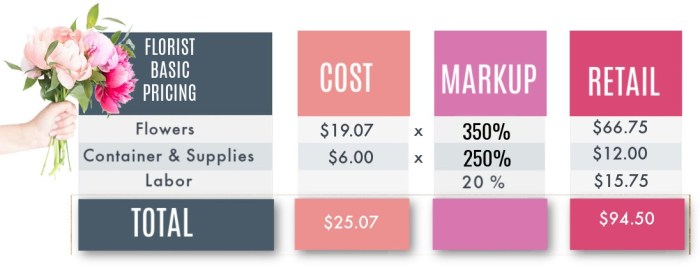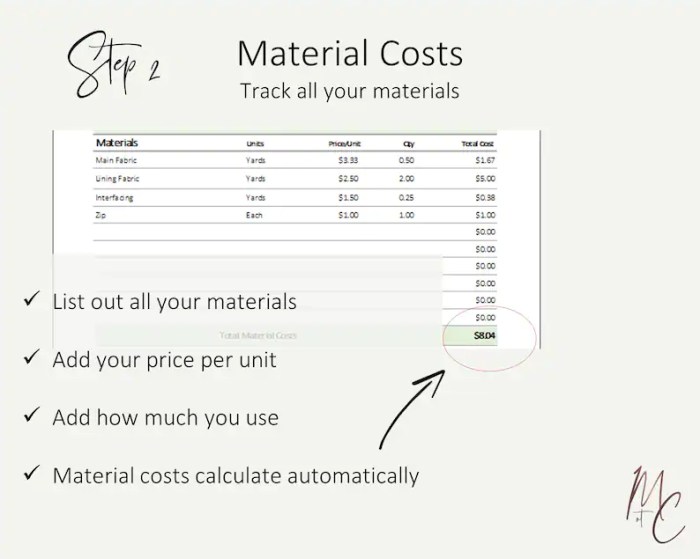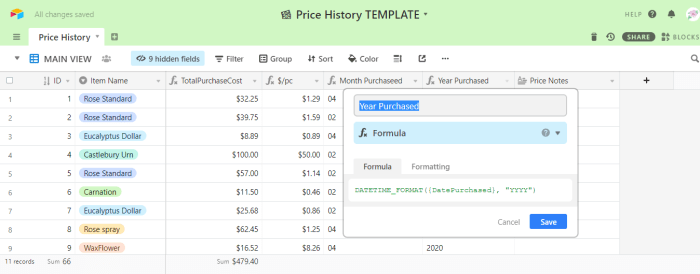Embark on a journey of floral pricing mastery with our comprehensive Floral Pricing Worksheet Answer Key. Delve into the intricacies of floral costs, pricing strategies, and worksheet creation, empowering you to set profitable prices that bloom with success.
Unveiling the secrets of floral pricing, this guidebook provides a roadmap to understanding the factors that shape floral costs, from materials to labor and overhead expenses. Discover the nuances of market demand, competition, and profit margins, ensuring your prices align with industry standards and customer expectations.
Floral Pricing Worksheet Overview

A floral pricing worksheet is a tool used by florists to determine the cost of floral arrangements. It helps florists calculate the cost of materials, labor, and overhead expenses associated with creating a floral arrangement. The worksheet also allows florists to set a price for the arrangement that will generate a profit.
Key Components
The key components of a floral pricing worksheet include:
- The cost of materials: This includes the cost of flowers, greens, and other materials used in the arrangement.
- The cost of labor: This includes the cost of the florist’s time to create the arrangement.
- The cost of overhead expenses: This includes the cost of rent, utilities, and other expenses associated with running the florist shop.
- The profit margin: This is the amount of profit that the florist wants to make on the arrangement.
Understanding Floral Costs: Floral Pricing Worksheet Answer Key

Understanding the various cost components involved in floral arrangements is crucial for accurate pricing. Floral costs encompass materials, labor, and overhead expenses, each of which must be carefully considered to ensure profitability.
Materials Costs
Materials costs constitute the expenses incurred in acquiring the raw materials used in floral arrangements. These include:
- Flowers: The cost of flowers varies depending on the type, seasonality, availability, and quality.
- Foliage: Greenery and foliage add texture and depth to arrangements, and their costs vary based on the species and quantity.
- Vases and containers: The type and size of vases or containers used impact the cost.
- Floral supplies: Floral foam, wire, tape, and other supplies are essential for assembling arrangements.
Labor Costs
Labor costs encompass the wages and benefits paid to individuals involved in the creation and delivery of floral arrangements. These include:
- Designers: Designers create and assemble the arrangements, and their skill level and experience influence their hourly rates.
- Assistants: Assistants help with tasks such as preparing materials, cleaning, and delivering arrangements.
- Delivery drivers: Drivers deliver arrangements to customers, and their costs include wages, fuel, and vehicle maintenance.
Overhead Expenses
Overhead expenses are indirect costs associated with running a floral business. These include:
- Rent: The cost of renting a physical space for the business.
- Utilities: Expenses such as electricity, water, and gas.
- Marketing and advertising: Costs incurred in promoting the business.
- Insurance: Liability insurance and other forms of coverage.
- Depreciation: The decrease in value of assets over time.
Setting Floral Prices

Establishing appropriate prices for floral arrangements is crucial for businesses to ensure profitability while remaining competitive in the market. Several pricing strategies are commonly employed in the floral industry.
Understanding market demand, competition, and profit margins is essential when setting prices. Market demand refers to the quantity of floral products that consumers are willing and able to purchase at a given price. Competition involves analyzing the pricing strategies of similar businesses in the area, as well as identifying their strengths and weaknesses.
Profit margins represent the difference between the cost of goods sold and the selling price, and they determine the profitability of a floral business.
Cost-Plus Pricing
Cost-plus pricing involves adding a fixed markup percentage to the total cost of producing an arrangement. This method ensures a consistent profit margin regardless of the arrangement’s complexity or materials used.
Value-Based Pricing
Value-based pricing focuses on the perceived value of an arrangement to the customer rather than its cost. This strategy involves determining the maximum price that customers are willing to pay based on the arrangement’s aesthetics, uniqueness, and emotional appeal.
Competitive Pricing, Floral pricing worksheet answer key
Competitive pricing involves setting prices that are comparable to those of similar businesses in the area. This strategy helps maintain market share and attract customers who are price-sensitive.
Dynamic Pricing
Dynamic pricing involves adjusting prices based on factors such as seasonality, availability of materials, and customer demand. This strategy allows businesses to maximize revenue during peak seasons and minimize losses during off-seasons.
Creating a Floral Pricing Worksheet

A floral pricing worksheet is a valuable tool for florists to calculate and present their pricing information clearly and effectively. Here’s a step-by-step guide on how to create one:
Gather Necessary Information
Start by gathering all the relevant information, including:
- Flower costs: Wholesale or retail prices of the flowers used in your arrangements.
- Labor costs: Hourly wages for the time spent creating the arrangements.
- Materials costs: Expenses for items like vases, ribbons, and greenery.
- Overhead costs: Rent, utilities, and other fixed business expenses.
- Profit margin: The desired percentage of profit you want to make on each arrangement.
Create a Spreadsheet
Use a spreadsheet software like Microsoft Excel or Google Sheets to create a worksheet. Organize the information into columns, with the following sections:
- Arrangement Description: List the name or description of each arrangement.
- Flower Costs: Calculate the cost of the flowers used in each arrangement based on the wholesale or retail prices.
- Labor Costs: Estimate the time it takes to create each arrangement and multiply it by the hourly wage.
- Materials Costs: Add up the expenses for any additional materials used.
- Overhead Costs: Determine the overhead costs associated with each arrangement based on the percentage of time spent on it.
- Total Costs: Sum up all the costs to determine the total cost of each arrangement.
- Profit Margin: Apply the desired profit margin to the total costs to calculate the selling price.
Present the Information
Once you have calculated the pricing for each arrangement, present the information clearly and concisely. Use formatting options like bold, italics, and color coding to highlight important information.
Additional Tips
Consider these additional tips for creating an effective floral pricing worksheet:
- Update regularly: Review and adjust the pricing worksheet periodically to account for changes in costs or market conditions.
- Use industry benchmarks: Compare your pricing with industry averages or competitors to ensure you are competitive.
- Offer tiered pricing: Provide discounts for larger orders or bulk purchases.
Using a Floral Pricing Worksheet
Floral pricing worksheets are essential tools for managing floral costs and pricing. They help florists track expenses, calculate markup, and adjust prices based on market factors and customer preferences.
Benefits of Using a Floral Pricing Worksheet
- Accurate Costing:Worksheets allow florists to accurately track the costs associated with each floral arrangement, including materials, labor, and overhead expenses.
- Markup Calculation:Worksheets help florists determine the appropriate markup to apply to their costs to ensure profitability.
- Price Adjustments:Worksheets provide a framework for adjusting prices based on seasonal factors, availability of flowers, and customer preferences.
- Transparency:Worksheets provide a clear record of pricing calculations, ensuring transparency with customers and stakeholders.
Adjusting Prices Based on Seasonal Factors, Availability, and Customer Preferences
Floral prices can fluctuate significantly based on seasonal factors and availability. During peak seasons, when flowers are in high demand, prices tend to be higher. In off-seasons, prices may be lower due to reduced demand. Worksheets allow florists to adjust prices accordingly to ensure profitability while remaining competitive.
Availability of flowers can also impact pricing. Certain flowers may be more expensive if they are out of season or difficult to obtain. Worksheets help florists account for these factors and adjust prices accordingly.
Customer preferences can also influence pricing. Some customers may be willing to pay a premium for specific flowers or arrangements. Worksheets allow florists to adjust prices based on customer preferences and target different market segments.
Additional Considerations
In addition to the basic components of floral pricing, there are several additional considerations that florists must account for when setting their prices. These include special requests and custom orders, as well as negotiating prices with customers and suppliers.
Special requests and custom orders can significantly impact the cost of a floral arrangement. For example, if a customer requests a specific type of flower that is not in season, the florist may need to pay a premium price to obtain it.
Similarly, if a customer requests a complex or intricate design, the florist may need to charge more for their labor.
Negotiating Prices
Florists should be prepared to negotiate prices with both customers and suppliers. When negotiating with customers, it is important to be firm but fair. Florists should be willing to compromise, but they should also be aware of their own costs and ensure that they are making a profit.
When negotiating with suppliers, florists should be prepared to research prices from multiple vendors. They should also be willing to negotiate discounts for bulk orders or long-term contracts.
FAQ Compilation
What is the purpose of a floral pricing worksheet?
A floral pricing worksheet is a tool that helps florists determine the appropriate prices for their floral arrangements, considering factors such as materials, labor, and overhead expenses.
How do I calculate the cost of materials for a floral arrangement?
The cost of materials includes the cost of flowers, greenery, containers, and any other supplies used in creating the arrangement. It can be calculated by adding up the individual costs of each item.
What is a markup?
A markup is the difference between the cost of an item and its selling price. It is typically expressed as a percentage of the cost.